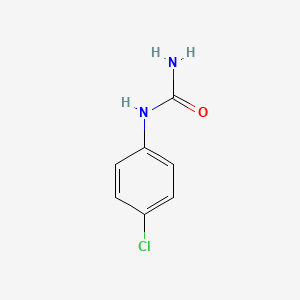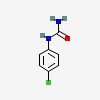4-Chlorophenylurea
- 4-Chlorophenylurea
- 140-38-5
- 1-(4-chlorophenyl)urea
- (4-CHLOROPHENYL)UREA
- Urea, (4-chlorophenyl)-
- Create:2005-03-26
- Modify:2025-01-18

- 4-Chlorophenylurea
- 140-38-5
- 1-(4-chlorophenyl)urea
- (4-CHLOROPHENYL)UREA
- Urea, (4-chlorophenyl)-
- (p-Chlorophenyl)urea
- p-CPU
- Urea, (p-chlorophenyl)-
- Urea, N-(4-chlorophenyl)-
- 1-(p-Chlorophenyl)urea
- N-(4-Chlorophenyl)urea
- Urea, 1-(p-chlorophenyl)-
- UNII-52HM99ELKB
- EINECS 205-412-6
- 52HM99ELKB
- NSC 12971
- BRN 0908492
- DTXSID5041512
- AI3-20197
- NSC12971
- MFCD00014788
- NSC-12971
- NSC-400071
- 3-(P-CHLOROPHENYL)UREA
- DTXCID3021512
- P-CHLOROPHENYLUREA
- (4-Chlorophenyl)urea; GW 557278X; SKF-32360; Proguanil related; Chlorhexidine Diacetate Impurity F; Chlorhexidine Impurity F
- 4-Chlorophenyl urea
- CPU 4-chlorophenylurea
- 3-(4-chlorophenyl)urea
- Maybridge1_007118
- N-(4-Chlorophenyl)urea #
- MLS001005702
- SCHEMBL224279
- CHEMBL1544569
- HMS561L12
- Urea, (p-chlorophenyl)-(8CI)
- HMS2756H14
- Tox21_300837
- NSC400071
- STK368443
- AKOS000200346
- NCGC00246128-01
- NCGC00246128-02
- NCGC00254741-01
- CAS-140-38-5
- SMR000348912
- HY-129973
- CS-0108955
- NS00021640
- EN300-14986
- D84244
- 12F-909
- AR-360/40260054
- J-007381
- Q27261007
- Z56754682
- CHLORHEXIDINE DIACETATE IMPURITY F [EP IMPURITY]
157.0179 999
72.0444 192
143.0023 90
128.9866 75
114.971 57
157.0179 999
72.0444 351
143.0024 94
128.9866 85
114.971 63
126.0116 999
41.998537 540
169.017414 75
34.969401 54
100.96739 14
93.057301 999
66.046402 146
98.999604 95
75.022927 82
92.049476 50


H301 (89.5%): Toxic if swallowed [Danger Acute toxicity, oral]
H315 (98.2%): Causes skin irritation [Warning Skin corrosion/irritation]
H317 (89.5%): May cause an allergic skin reaction [Warning Sensitization, Skin]
H319 (98.2%): Causes serious eye irritation [Warning Serious eye damage/eye irritation]
H335 (98.2%): May cause respiratory irritation [Warning Specific target organ toxicity, single exposure; Respiratory tract irritation]
P261, P264, P264+P265, P270, P271, P272, P280, P301+P316, P302+P352, P304+P340, P305+P351+P338, P319, P321, P330, P332+P317, P333+P317, P337+P317, P362+P364, P403+P233, P405, and P501
(The corresponding statement to each P-code can be found at the GHS Classification page.)
Aggregated GHS information provided per 57 reports by companies from 7 notifications to the ECHA C&L Inventory. Each notification may be associated with multiple companies.
Reported as not meeting GHS hazard criteria per 1 of 57 reports by companies. For more detailed information, please visit ECHA C&L website.
There are 6 notifications provided by 56 of 57 reports by companies with hazard statement code(s).
Information may vary between notifications depending on impurities, additives, and other factors. The percentage value in parenthesis indicates the notified classification ratio from companies that provide hazard codes. Only hazard codes with percentage values above 10% are shown.
Acute Tox. 3 (89.5%)
Skin Irrit. 2 (98.2%)
Skin Sens. 1 (89.5%)
Eye Irrit. 2 (98.2%)
STOT SE 3 (98.2%)
Patents are available for this chemical structure:
https://patentscope.wipo.int/search/en/result.jsf?inchikey=RECCURWJDVZHIH-UHFFFAOYSA-N
- Burnham Center for Chemical Genomics
- CAS Common ChemistryLICENSEThe data from CAS Common Chemistry is provided under a CC-BY-NC 4.0 license, unless otherwise stated.https://creativecommons.org/licenses/by-nc/4.0/4-Chlorophenylureahttps://commonchemistry.cas.org/detail?cas_rn=140-38-5
- ChemIDplusUrea, (4-chlorophenyl)-https://pubchem.ncbi.nlm.nih.gov/substance/?source=chemidplus&sourceid=0001967266ChemIDplus Chemical Information Classificationhttps://pubchem.ncbi.nlm.nih.gov/source/ChemIDplus
- DTP/NCILICENSEUnless otherwise indicated, all text within NCI products is free of copyright and may be reused without our permission. Credit the National Cancer Institute as the source.https://www.cancer.gov/policies/copyright-reuse
- EPA DSSTox4-Chlorophenylureahttps://comptox.epa.gov/dashboard/DTXSID5041512CompTox Chemicals Dashboard Chemical Listshttps://comptox.epa.gov/dashboard/chemical-lists/
- European Chemicals Agency (ECHA)LICENSEUse of the information, documents and data from the ECHA website is subject to the terms and conditions of this Legal Notice, and subject to other binding limitations provided for under applicable law, the information, documents and data made available on the ECHA website may be reproduced, distributed and/or used, totally or in part, for non-commercial purposes provided that ECHA is acknowledged as the source: "Source: European Chemicals Agency, http://echa.europa.eu/". Such acknowledgement must be included in each copy of the material. ECHA permits and encourages organisations and individuals to create links to the ECHA website under the following cumulative conditions: Links can only be made to webpages that provide a link to the Legal Notice page.https://echa.europa.eu/web/guest/legal-notice(4-chlorophenyl)ureahttps://echa.europa.eu/substance-information/-/substanceinfo/100.004.921(4-chlorophenyl)urea (EC: 205-412-6)https://echa.europa.eu/information-on-chemicals/cl-inventory-database/-/discli/details/73270
- FDA Global Substance Registration System (GSRS)LICENSEUnless otherwise noted, the contents of the FDA website (www.fda.gov), both text and graphics, are not copyrighted. They are in the public domain and may be republished, reprinted and otherwise used freely by anyone without the need to obtain permission from FDA. Credit to the U.S. Food and Drug Administration as the source is appreciated but not required.https://www.fda.gov/about-fda/about-website/website-policies#linking4-CHLOROPHENYLUREAhttps://gsrs.ncats.nih.gov/ginas/app/beta/substances/52HM99ELKB
- ChEMBLLICENSEAccess to the web interface of ChEMBL is made under the EBI's Terms of Use (http://www.ebi.ac.uk/Information/termsofuse.html). The ChEMBL data is made available on a Creative Commons Attribution-Share Alike 3.0 Unported License (http://creativecommons.org/licenses/by-sa/3.0/).http://www.ebi.ac.uk/Information/termsofuse.html
- Japan Chemical Substance Dictionary (Nikkaji)
- MassBank Europe
- MassBank of North America (MoNA)LICENSEThe content of the MoNA database is licensed under CC BY 4.0.https://mona.fiehnlab.ucdavis.edu/documentation/license
- NIST Mass Spectrometry Data CenterLICENSEData covered by the Standard Reference Data Act of 1968 as amended.https://www.nist.gov/srd/public-lawUrea, (4-chlorophenyl)-http://www.nist.gov/srd/nist1a.cfm
- SpectraBase1-(4-Chlorophenyl)ureahttps://spectrabase.com/spectrum/6cd5cuxltpR1-(4-Chlorophenyl)ureahttps://spectrabase.com/spectrum/LFcOsex0yzo(p-CHLOROPHENYL)UREAhttps://spectrabase.com/spectrum/E3rFBzwPp53(4-Chlorophenyl)-ureahttps://spectrabase.com/spectrum/9zcC7BezUdc(p-chlorophenyl)ureahttps://spectrabase.com/spectrum/12Nh2lnaQuA(4-Chlorophenyl)ureahttps://spectrabase.com/spectrum/I1xGxxpsOn6(4-Chlorophenyl)ureahttps://spectrabase.com/spectrum/E39U1uZZfSC
- NORMAN Suspect List ExchangeLICENSEData: CC-BY 4.0; Code (hosted by ECI, LCSB): Artistic-2.0https://creativecommons.org/licenses/by/4.0/NORMAN Suspect List Exchange Classificationhttps://www.norman-network.com/nds/SLE/
- Springer Nature
- Thieme ChemistryLICENSEThe Thieme Chemistry contribution within PubChem is provided under a CC-BY-NC-ND 4.0 license, unless otherwise stated.https://creativecommons.org/licenses/by-nc-nd/4.0/
- Wikidata4-chlorophenylureahttps://www.wikidata.org/wiki/Q27261007
- Wiley
- PubChem
- GHS Classification (UNECE)GHS Classification Treehttp://www.unece.org/trans/danger/publi/ghs/ghs_welcome_e.html
- EPA Substance Registry ServicesEPA SRS List Classificationhttps://sor.epa.gov/sor_internet/registry/substreg/LandingPage.do
- MolGenieMolGenie Organic Chemistry Ontologyhttps://github.com/MolGenie/ontology/
- PATENTSCOPE (WIPO)SID 403429629https://pubchem.ncbi.nlm.nih.gov/substance/403429629





